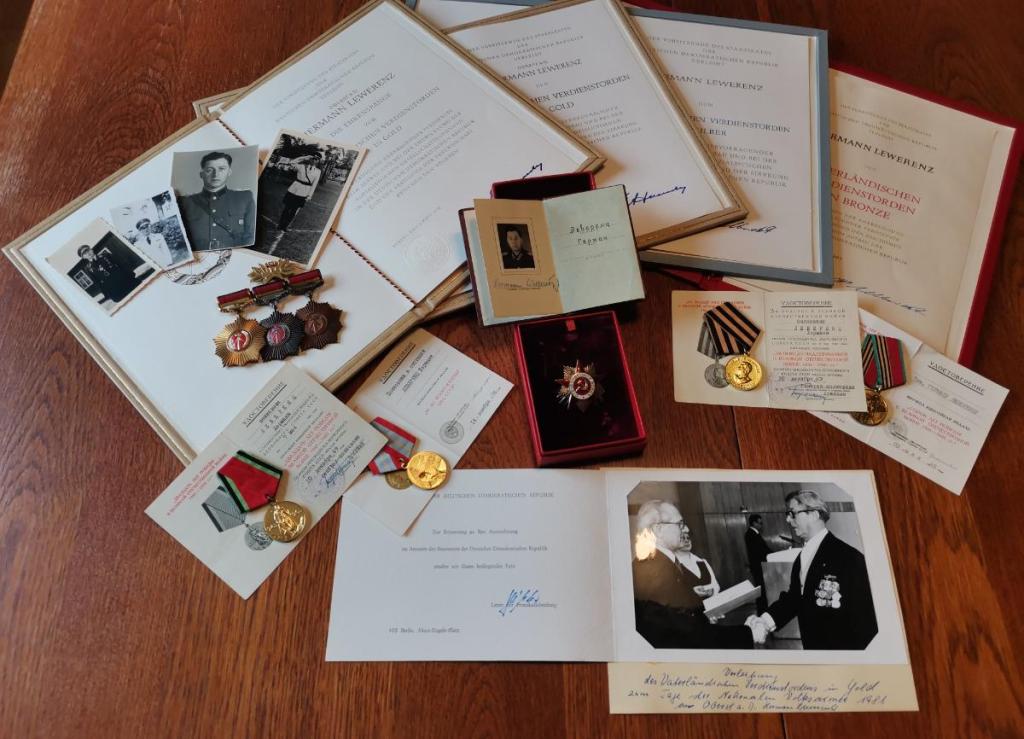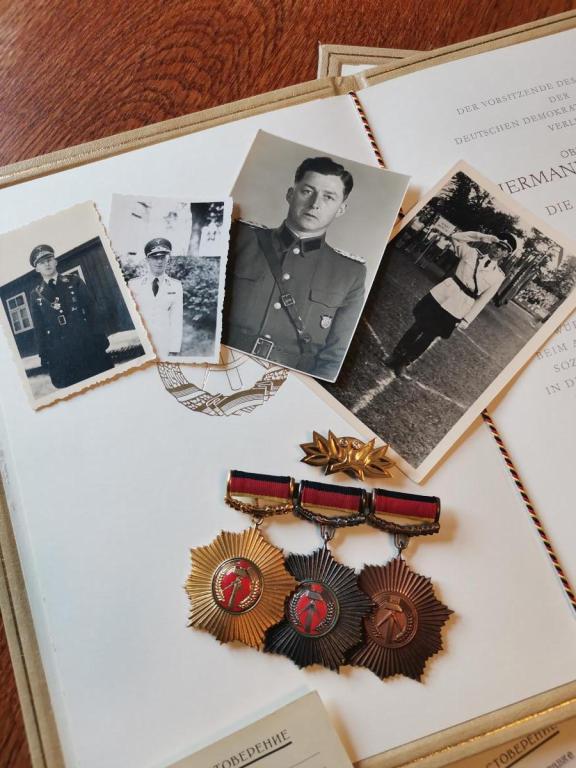-
Posts
1,147 -
Joined
-
Last visited
-
Days Won
12
Content Type
Profiles
Forums
Blogs
Gallery
Events
Store
Posts posted by Elmar Lang
-
-
Hello Leonardo,
it's really nice reading from you on this Forum!
The document hereby posted, is of great historical interest, for its accuracy, neat calligraphy and personal notes (even poetry!), besides knowing that this officer couldn't survive the war as a consequence of his wounds.
Your contributions shall always be welcome!
All the best,
Enzo (E.L.)
0 -
Hello Carlo,
your fine medal for 40 years faithful service as a civil servant is preserved in a surely privately-made case, probably originally made for a pocket watch, then adapted with the velvet-lined, fitted compartment.
It's nice to see posts from other Italian collectors of Austro Hungarian awards and historical artifacts.
Best wishes,
E.L.
2 -
Would it be possible to see the piece on which these marks have been struck? This would help quite a lot.
Many thanks in advance,
E.L.
0 -
Hello,
thank you for sharing the pictures of your fine pieces.
I'm from Italy, but since decades I collect Imperial Austrian awards.
I see a beautiful, early KD Leopold Orden in its proper case, with early maker's mark of Rothe...
The MMTO looks very interesting too...
0 -
Drugo, your correction gives the right description of what's said in the "motivazione".
0 -
Let's not forget that the "A" mark was struck on the rim of silver and gold medals from 1867 onwards.
In the case of the Emperor Ferdinand type 1st Class medals, the suspension appears as modified from the larger loop to the one as known on the gold and silver bravery medals, Emperor Franz Josef type, from 1848/49 until 1914 (for the gold ones, until 1916/17).
1 -
In this case, you are the lucky owner of a very early triangular ribbon. Its purple colour is typical of those issued in the 1848-1859 period.
Of course it happened that this type of ribbon could have been used later too, or simply changed from a medal to another one.
All the best,
Enzo
2 -
you're welcome!
1 -
Hello,
I can only congratulate for the beautiful, early Marianer-Kreuz, that's preserved in its original case of Gebr. Resch, Vienna.
All is correct, and all parts appear as belonging to each other, including the black ribbon.
All the best,
Enzo
2 -
Hello,
recently, I've purchased the group of orders and decorations belonged to Hermann Lewerenz, a Luftwaffe officer captured in the last days of the Stalingrad battle, shortly before the surrender of v. Paulus's 6th Army.
Lewerenz was amongst the first members of the Bund Deutsche Offiziere and the Komitee Freies Deutschland; after the war, he entered in the KVP, then the NVA, reaching the rank of Oberst.
He was a consultatnt in the movie industry, and I've read that he was an actor too. I hope I will know or find more about his life and career.
Besides his full set of the Vaterländisches Verdienstorden, he received some soviet awards; one of them, the Order of the Patriotic War 2nd Class; also this, cased and with its Ordenskaya Knizhka...
All the best,
Enzo
0 -
Zimbler is the best known maker of the "Spangen für wiederholte Verleihung" especially because most of their products were marked to the reverse, but many producers made and supplied these pieces, most of them, without putting their marks on them.
There exist bars in silver too and, towards the end of the hostilities, also made of various metal alloys.
All the best,
Enzo
0 -
A very interesting miniature group. Any idea about its original owner?
0 -
Interesting, thank you. The award document doesn't mention his military rank, but only that he had within the Tsar's court, a rank that in German would have been that of "Hof-Marschall"
0 -
Hello,
after the withdrawal of the Turks from Lybia, the territory was not in peace, but the struggle against rebel tribes continued.
During WW1 Lybia was almost completely lost, besides keeping control of Tripoli and the coastal cities and a few more settlements.
After the end of WW1, Italy took further action of both pacification and repression of insurgents and rebel tribes.
Most probably, Negusse Ailenchiel was a Zaptié (native, colonial Carabinieri) or a soldier from one of the battalions from Erithrea. Pity, his name is not present in the roll published by the Nastro Azzurro Institute. This roll is still incomplete, although listing almost all the decorated from 1833 onwards,
Would you please provide a picture of your interesting medal?
Best wishes,
Enzo (E.L.)
0 -
Hello,
for unknown reasons, one of the many bars for the Lybia medal was put on the ribbon of this Ethiopian Campaign commemorative medal.
All the best,
Enzo (E.L.)
0 -
Hello,
what does "German made" mean?
Being made in the 30s, it should be a wearer's copy.
Is it made in gold or gilt metal?
As previously said, a photo would help a lot.
0 -
The complete family name is Anrep Elmpt
1 -
Personal and family reasons kept me offline in the days when H.M. the Queen Elizabeth II passed away, thus being this late.
I would like to express my sorrow to all the fellow members of GMIC from the United Kingdom and the Commonwealth.
Enzo Calabresi, Italy
1 -
helIo,
I hope not to upset the apple cart, but after my own, perhaps limited experience, I'd dare to say that not all modern ribbons are chain stitched. There are manufacturers, still making them in the warp/weft pattern. Where the difference from older ones, depends on the materials used to make them.
Let's never forget, that a forger, quite often uses original ribbons, same as a forger of old masters' paintings often uses (otherwise expensive) original pigments and tools, for his creations: the quality of the material used, depends on the target: a high-end collector or an avid, but unexperienced one.
Modern-made ribbons are a solution for fast-selling fakes (besides the honest replacement of temporarily unavailable original ones), especially via-the web or flea-markets, targeting to the already mentioned, unexperienced collectors.
I would like to add a further "alarm-bell" towards certain modern ribbons, that appear as having been "age-enhanced", by immersion in tea or diluted coffee: they're quite soft and the white sections are of a uniform yellow-brownish shade (see the bavarian bar, illustrated in detail on May 6th's post). Such ribbons do exist either in the chain-stitchen and warp/weft pattern. Usually, the tea/coffee aged, soft ribbons are typical of the mass-produced fakes of a now passed away, german faker, whose "workshop leftovers" apparently are widely used by further, modern creatives.
A German collector, decades ago, proudly said at a collectors' meeting "Lernen vom Original!" (learn from the originals!)... very wise words, but pity, he too was the victim of a fantastic, extremely creative forger.
There's not a rule, to detect a falsification. A falsification, can be detected thanks to the experience acquired through study, confrontation, research and even after having learned something, after instructive mistakes.
All the best,
Enzo (E.L.)
1 -
Hello,
better and sharper pictures could help, but I think that the piece could have been manufactured by Rothe, Vienna.
It is an excellently-made piece: no surprise that there wouldn't be any star-mark; it happens.
Same as it happens to see pieces made of gold, also without any mark: these pieces usually make collectors very happy.
All the best,
Enzo (E.L.)
1 -
Hello,
nice group, showing an otherwise wrongly-mounted bar.
Firstly, the Silberne Tapferkeitsmedaille 2.Klasse type Kaisr Franz Joseph should take the first place.
Secondarily, the ribbons after the first award should be "under" each other.
Said that, a further interesting witness of what happened especially after WW1.
Best wishes,
Enzo (E.L.)
0 -
Nice group indeed, belonged to a Bulgarian court dignitary
0 -
Thank you Tomas,
I agree with you, attributing that EKO-III Kl.m.d.KD u.Schw. to the manufacture of G.A. Scheid.
Being presently away from home and the availability of my collection I am unable to give more help on this subject, where my memory fails re. variations and their makers.
Your contribution is again an invaluable one, giving more, precious info about the fine, hereby discussed wartime piece.
All the best,
Enzo (E.L.)
0 -
Hello,
I regret to say that this is one of the "legends", quickly spreading around thanks to the web and some of its self-appointed gurus.
I repeat that like in any field of collecting, also the imperial austrian phaleristic needs study and research, in order to build up a good experience.
Again, I would like to suggest that the best investment, would be to buy the three parts (2-volumes each) of the Ludwigstorff-Ortner work.
The Edition in the English language is excellently done, so that also the non-German speaking community, will have the opportunity to easily study the subject.
0






Signum laudis with a small box
in Austro-Hungarian Empire
Posted
A nice case, where the Militärverdienstmedaille was stored at retailers, thus, without ribbon.
The buyer, entitled to wear the medal, had then the choice of the proper ribbon.
In fact, the reverse of the case opening this thread, shows the handwritten note (probably by hand of the original seller):
5,40 Ohne
Band
70
_____
6,10
Explaining the price of the medal without ribbon and of the ribbon itself: interesting data anyway.
All the best,
Enzo